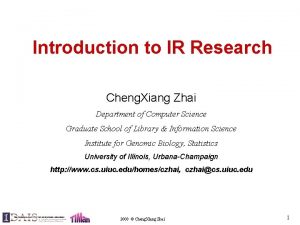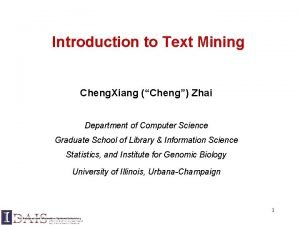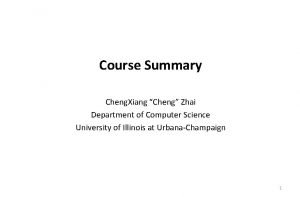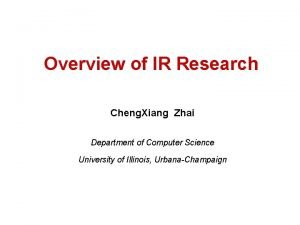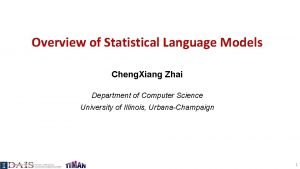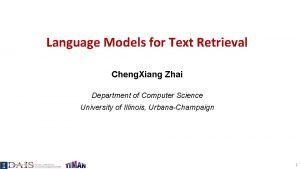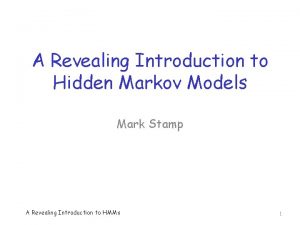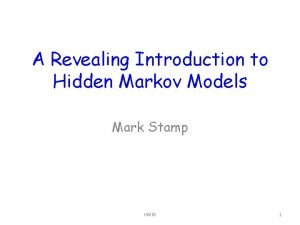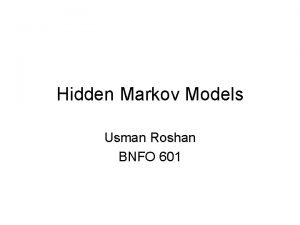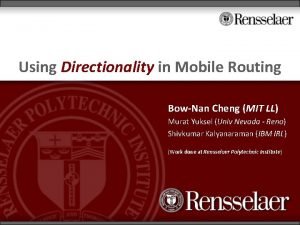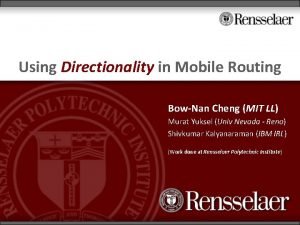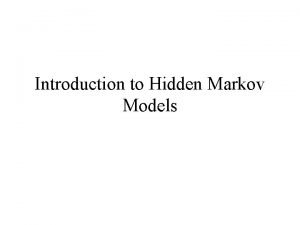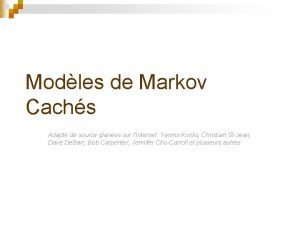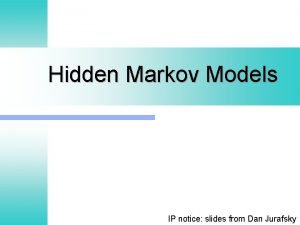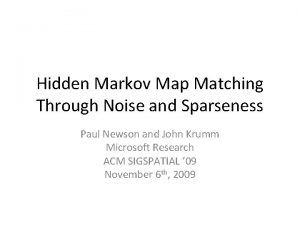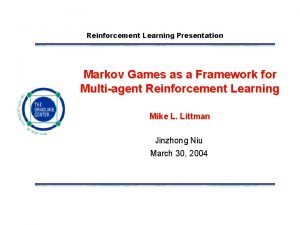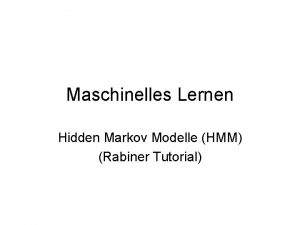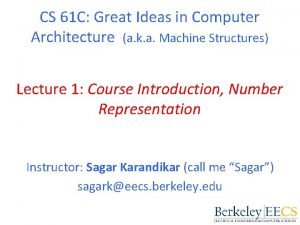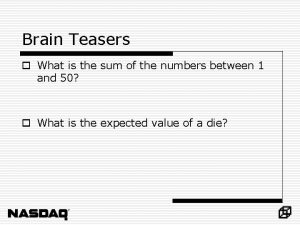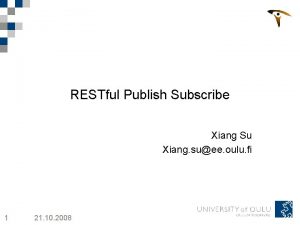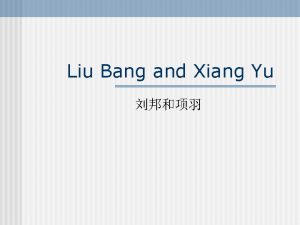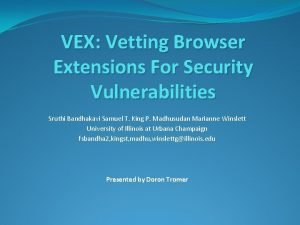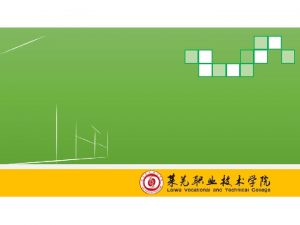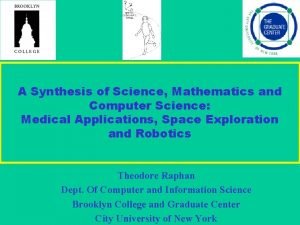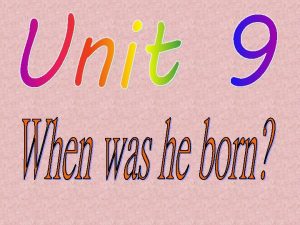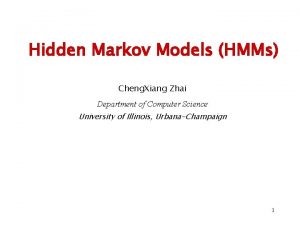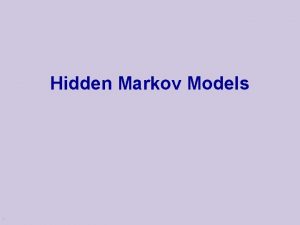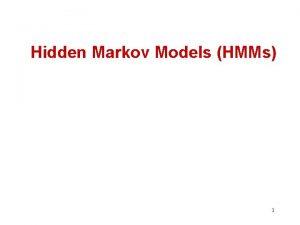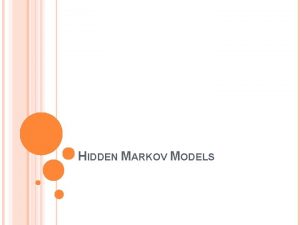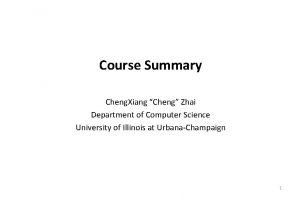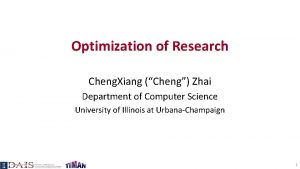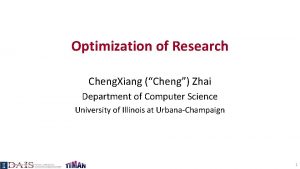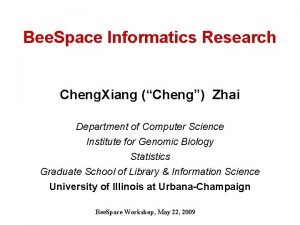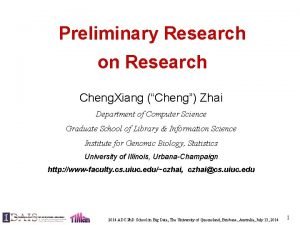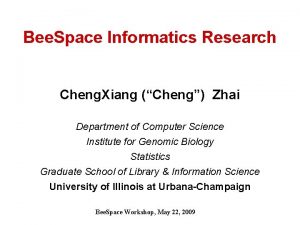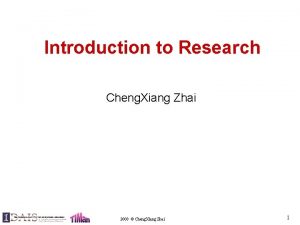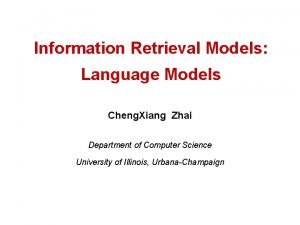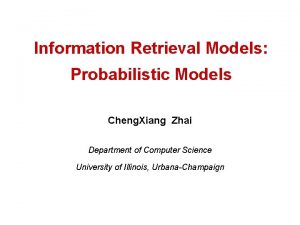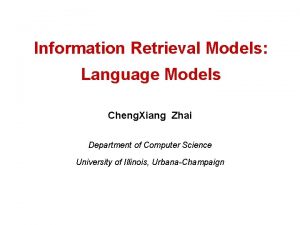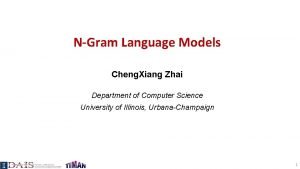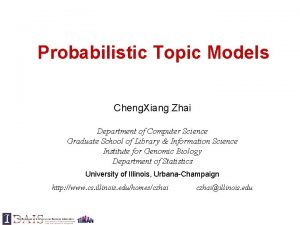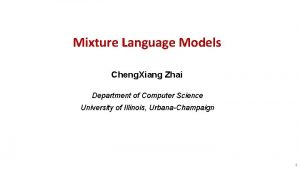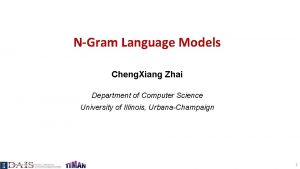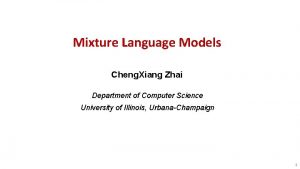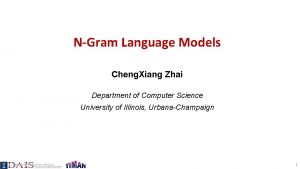Hidden Markov Models HMMs Cheng Xiang Zhai Department

































![Readings • Read [Rabiner 89] sections I, III • Read the “brief note” 34 Readings • Read [Rabiner 89] sections I, III • Read the “brief note” 34](https://slidetodoc.com/presentation_image_h2/c9abb97510ba6ec2b2ce3a59007d3189/image-34.jpg)
- Slides: 34

Hidden Markov Models (HMMs) Cheng. Xiang Zhai Department of Computer Science University of Illinois, Urbana-Champaign 1

Central Questions to Ask about a LM: “ADMI” • Application: Why do you need a LM? For what purpose? Evaluation metric for a LM Topic mining and analysis Sequential structure discovery • Data: What kind of data do you want to model? Data set for estimation & evaluation Sequence of words • Model: How do you define the model? Assumptions to be made Latent state, Markov assumption • Inference: How do you infer/estimate the parameters? Viterbi, Baum-Welch Inference/Estimation algorithm 2

Modeling a Multi-Topic Document A document with 2 subtopics, thus 2 types of vocabulary … text mining passage How do we model such a document? food nutrition passage How do we “generate” such a document? text mining passage How do we estimate our model? food nutrition passage … We’ve already seen one solution – unigram mixture model + EM This lecture is about another (better) solution – HMM + EM 3

Simple Unigram Mixture Model … Model/topic 1 p(w| 1) text 0. 2 mining 0. 1 assocation 0. 01 clustering 0. 02 … food 0. 00001 =0. 7 … … Model/topic 2 food 0. 25 nutrition 0. 1 p(w| 2) 1 - =0. 3 healthy 0. 05 diet 0. 02 … p(w| 1 2) = p(w| 1)+(1 - )p(w| 2) 4

Deficiency of the Simple Mixture Model • Adjacent words are sampled independently • Cannot ensure passage cohesion • Cannot capture the dependency between neighboring words We apply the text mining algorithm to the nutrition data to find patterns … Topic 1= text mining p(w| 1) Topic 2= health p(w| 2) Solution=? 5

The Hidden Markov Model Solution • Basic idea: – Make the choice of model for a word depend on the choice of model for the previous word – Thus we model both the choice of model (“state”) and the words (“observations”) O: We apply the text mining algorithm to the nutrition data to find patterns … S 1: 1 1 1 1 …… O: We apply the text mining algorithm to the nutrition data to find patterns … S 2: 1 1 1 1 2 1 1 P(O, S 1) > p(O, S 2)? 6

Another Example: Passage Retrieval q Strategy I: Build passage index w Need pre-processing w Query independent boundaries Relevant w Efficient Passages (“T”) q Strategy II: Extract relevant passages dynamically w No pre-processing w Dynamically decide the boundaries Background text (“B”) w Slow O: We apply the text mining algorithm to the nutrition data to find patterns … S 1: B T T T BB T T O: …. . We apply the text mining … patterns. ……………… S 2: BB. . . BB T T T …. T BB…. . BBBB 7

A Simple HMM for Recognizing Relevant Passages 0. 8 P(B)=0. 5 P(T)=0. 5 Parameters 0. 2 B P(w|B) the 0. 2 a 0. 1 we 0. 01 to 0. 02 … text 0. 0001 mining 0. 00005 … Background T 0. 5 P(w|T) … text =0. 125 mining = 0. 1 association =0. 1 clustering = 0. 05 Initial state prob: p(B)= 0. 5; p(T)=0. 5 State transition prob: p(B B)=0. 8 p(B T)=0. 2 p(T B)=0. 5 p(T T)=0. 5 Output prob: P(“the”|B) = 0. 2 … P(“text”|T) = 0. 1 … … Topic 8

A General Definition of HMM Initial state probability: N states State transition probability: M symbols Output probability: 9

How to “Generate” Text? P(w|B) 0. 8 the 0. 2 a 0. 1 we 0. 01 is 0. 02 … method 0. 0001 mining 0. 00005 0. 2 P(B)=0. 5 B 0. 2 the … B … 0. 5 P(w|T) 0. 5 T 0. 5 0. 125 text T 0. 5 0. 1 text =0. 125 mining = 0. 1 algorithm =0. 1 clustering = 0. 05 T 0. 5 0. 1 … P(T)=0. 5 B 0. 8 B 0. 02 mining algorithm is 0. 2 0. 1 a T 0. 5 0. 05 B 0. 0001 clustering method P(BTT…, ”the text mining…”)=p(B)p(the|B) p(T|B)p(text|T) p(T|T)p(mining|T)… = 0. 5*0. 2 * 0. 2*0. 125 * 0. 5*0. 1… 10

HMM as a Probabilistic Model Time/Index: t 1 Data: o 1 t 2 o 2 t 3 o 3 t 4 … o 4 … Observation variable: O 1 O 2 O 3 O 4 … Hidden state variable: S 1 S 2 S 3 S 4 … Sequential data Random variables/ process State transition prob: Probability of observations with known state transitions: Joint probability (complete likelihood): Init state distr. Output prob. Probability of observations (incomplete likelihood): State trans. prob. 11

Three Problems 1. Decoding – finding the most likely path Given: model, parameters, observations (data) Find: most likely states sequence (path) 2. Evaluation – computing observation likelihood Given: model, parameters, observations (data) Find: the likelihood to generate the data 12

Three Problems (cont. ) 3. Training – estimating parameters - Supervised Given: model structure, labeled data( data+states sequence) Find: parameter values - Unsupervised Given: model structure, data (unlabeled) Find: parameter values 13

Problem I: Decoding/Parsing Finding the most likely path This is the most common way of using an HMM (e. g. , extraction, structure analysis)… 14

What’s the most likely path? P(w|B) 0. 8 the 0. 2 a 0. 1 we 0. 01 is 0. 02 … method 0. 0001 mining 0. 00005 0. 2 ? ? ? the ? ? text ? ? ? text =0. 125 mining = 0. 1 algorithm =0. 1 clustering = 0. 05 T P(B)=0. 5 ? … B … ? P(w|T) 0. 5 ? ? … P(T)=0. 5 ? ? ? mining algorithm is ? ? a ? ? ? clustering method 15

Viterbi Algorithm: An Example P(w|B) 0. 8 the 0. 2 a 0. 1 we 0. 01 … algorithm 0. 0001 mining 0. 005 text 0. 001 t= B 0. 8 0. 2 P(T)=0. 5 3 text 0. 8 0. 2 2 T B 5 0. 0. 5 algorithm … B 0. the 0. 05 text =0. 125 mining = 0. 1 algorithm =0. 1 clustering = 0. 05 4 … mining B 5 VP(B): VP(T) 0. 5 2 B T T P(B)=0. 5 the 0. 5 … 0. 2 1 0. 5 P(w|T) 0. 5 T 0. 5*0. 2 (B) 0. 5*0. 2*0. 8*0. 001(BB) … *0. 5*0. 005 (BTB) …*0. 5*0. 0001(BTTB) 0. 5*0. 05(T) 0. 5*0. 2*0. 125(BT) … *0. 5*0. 1 (BTT) …*0. 5*0. 1(BTTT) Winning path! 16

Viterbi Algorithm Observation: Algorithm: Prob. of best path ending at state i (Dynamic programming) Best path ending at state i Complexity: O(TN 2) 17

Problem II: Evaluation Computing the data likelihood § Another use of an HMM, e. g. , as a generative model for classification §Also related to Problem III – parameter estimation 18

Data Likelihood: p(O| ) t= 0. 5 1 2 the text 0. 8 B 0. 2 In general, T 0. 8 0. algorithm … 0. 8 B 0. 2 2 T B 5 0. 0. 5 4 … mining B 5 0. 5 3 0. 5 T enumerate all paths BB… B BT… B TT… T Complexity of a naïve approach? 19

The Forward Algorithm … … B B T T α 1 20

The Forward Algorithm … … α 1 B B T T α 2 21

The Forward Algorithm … … α 1 B B T T α 2 α 3 α 4 Generating o 1…ot with ending state si The data likelihood is Complexity: O(TN 2) 22

Forward Algorithm: Example t= 0. 5 1 2 the text 0. 8 B 0. 2 0. 8 0. algorithm … 0. 8 B 0. 2 2 0. 5 T B 5 0. 0. T 4 … mining B 5 0. 5 3 0. 5 T 0. 5 1(B): 0. 5*p(“the”|B) 2(B): [ 1(B)*0. 8+ 1(T)*0. 5]*p(“text”|B) …… 1(T): 0. 5*p(“the”|T) 2(T): [ 1(B)*0. 2+ 1(T)*0. 5]*p(“text”|T) …… T P(“the text mining algorithm”) = 4(B)+ 4(T) 23

The Backward Algorithm Observation: Algorithm: The data likelihood is (o 1…ot already generated) Starting from state si Generating ot+1…o. T Complexity: O(TN 2) 24

Backward Algorithm: Example t= 0. 5 1 2 the text 0. 8 B 0. 2 T … … 0. 8 0. algorithm … 0. 8 B 0. 2 2 T B 5 0. 0. 5 4 … mining B 5 0. 5 3 0. 5 T 0. 5 3(B): 0. 8*p(“alg”|B)* 4(B)+ 0. 2*p(“alg”|T)* 4(T) 3(T): 0. 5*p(“alg”|B)* 4(B)+ 0. 5*p(“alg”|T)* 4(T) T 4(B): 1 4(T): 1 P(“the text mining algorithm”) = 1(B)* 1(B)+ 1(T)* 1(T) = 2(B)* 2(B)+ 2(T)* 2(T) 25

Problem III: Training Estimating Parameters Where do we get the probability values for all parameters? Supervised vs. Unsupervised 26

Supervised Training Given: 1. N – the number of states, e. g. , 2, (s 1 and s 2) 2. V – the vocabulary, e. g. , V={a, b} 3. O – observations, e. g. , O=aaaaabbbbb 4. State transitions, e. g. , S=1121122222 Task: Estimate the following parameters 1=1/1=1; 2=0/1=0 1. 1, 2 a 11=2/4=0. 5; a 12=2/4=0. 5 2. a 11, a 12, a 21=1/5=0. 2; a 22=4/5=0. 8 3. b 1(a), b 1(b), b 2(a), b 2(b) 0. 5 P(s 1)=1 P(s 2)=0 0. 8 b 1(a)=4/4=1. 0; b 1(b)=0/4=0; b 2(a)=1/6=0. 167; b 2(b)=5/6=0. 833 0. 5 1 P(a|s 1)=1 P(b|s 1)=0 0. 2 2 P(a|s 2)=0. 167 P(b|s 2)=0. 833 27

Given: Unsupervised Training 1. N – the number of states, e. g. , 2, (s 1 and s 2) 2. V – the vocabulary, e. g. , V={a, b} 3. O – observations, e. g. , O=aaaaabbbbb 4. State transitions, e. g. , S=1121122222 Task: Estimate the following parameters 1. 1, 2 How could this be possible? 2. a 11, a 12, a 21 3. b 1(a), b 1(b), b 2(a), b 2(b) Maximum Likelihood: 28

Intuition O=aaaaabbbbb, P(O, q 1| ) q 1=11111 P(O, q 2| ) P(O, q. K| ) q 2=11111112211 … q. K=22222 New ’ Computation of P(O, qk| ) is expensive … 29

Baum-Welch Algorithm Basic “counters”: Being at state si at time t and at state sj at time t+1 Computation of counters: Complexity: O(N 2) 30

Baum-Welch Algorithm (cont. ) Updating formulas: Overall complexity for each iteration: O(TN 2) 31

An HMM for Information Extraction (Research Paper Headers) 32

What You Should Know • Definition of an HMM • What are three problems associated with an HMM? • Know how the following algorithms work – Viterbi algorithm – Forward & Backward algorithms • Know the basic idea of the Baum-Welch algorithm 33
![Readings Read Rabiner 89 sections I III Read the brief note 34 Readings • Read [Rabiner 89] sections I, III • Read the “brief note” 34](https://slidetodoc.com/presentation_image_h2/c9abb97510ba6ec2b2ce3a59007d3189/image-34.jpg)
Readings • Read [Rabiner 89] sections I, III • Read the “brief note” 34
 Cheng xiang zhai
Cheng xiang zhai Cheng xiang zhai
Cheng xiang zhai Cheng xiang zhai
Cheng xiang zhai Cheng xiang zhai
Cheng xiang zhai Cheng xiang zhai
Cheng xiang zhai Cheng xiang zhai
Cheng xiang zhai 鹅鹅鹅poem
鹅鹅鹅poem A revealing introduction to hidden markov models
A revealing introduction to hidden markov models A revealing introduction to hidden markov models
A revealing introduction to hidden markov models Hidden markov models
Hidden markov models Routing table
Routing table Morrp
Morrp Hidden markov chain
Hidden markov chain Hidden markov model tutorial
Hidden markov model tutorial Hidden markov model
Hidden markov model Hidden markov chain
Hidden markov chain Veton kepuska
Veton kepuska Hidden markov map matching through noise and sparseness
Hidden markov map matching through noise and sparseness Hidden markov model rock paper scissors
Hidden markov model rock paper scissors Hidden markov model beispiel
Hidden markov model beispiel Hmms
Hmms Molly zhai
Molly zhai Seth zhai
Seth zhai Rest publish subscribe
Rest publish subscribe Perfume xia xiang
Perfume xia xiang Xiang yu liu bang
Xiang yu liu bang Vex xiang
Vex xiang Vex xiang
Vex xiang Jessie xiang
Jessie xiang Liu xiang
Liu xiang Yongqing xiang
Yongqing xiang Liu xiang weightlifter
Liu xiang weightlifter Xiang jiao ping guo
Xiang jiao ping guo Xiang yang liu
Xiang yang liu Ba jin
Ba jin
